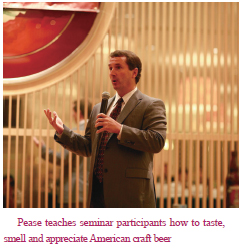Craft beer is finding new markets, and Bob Pease, vice president of Brewers Association, 'teaches' consumers about this new-old American tradition in 'beer school'
SMALL, independent craft brewers in the United States are behind the growing preference for very individual yet traditionally brewed beer. Now American craft beer is found in select establishments in Asia, including China, the Philippines and Singapore. American craft beer is generally agreed to mean all-malt beer brewed with traditional methods and ingredients, inspired by classic beer styles of Germany, England and Belgium. Brewed by small, independent breweries, craft beer offers a huge range of colors, flavors, strengths and sensations. Naturally, they make great companions to a wide world of foods. American craft beer is characterized by quality, flavor and diversity.  With assistance from the export development program of the U.S. Department of Agriculture, American craft beer is finding new markets outside the United States. "We target markets with disposable income," explains Robert "Bob" Pease, vice president of Brewers Association (BA), a not-forprofit trade and education association for American craft brewers and community of beer enthusiasts. Right now the biggest market for these craft beer is Scandinavia, but American craft brewers are targeting China, the world's largest beer market by volume. "China's beer market is just like the United States?20 years ago," explains Pease, "dominated by one style ?industrial light lager." To the BA, that makes China perfect for an introduction to the diverse, sometimes even quirky, craft beer from America. After success in cosmopolitan Beijing and Shanghai, where craft beer brands are gaining popularity in Western hotels, bars and restaurants, however, the concept remains unfamiliar to most Chinese consumers. Enter Pease, who has worked for the Brewers Association for over 15 years. He regularly leads educational seminars in the international marketplace, sharing information on the history of beer, how to appreciate the craft beer, the ingredients, storing and handling, and how to pair beer with food. The USDA Market Access Program and Emerging Markets Program sponsored the BA's series of seminars in China introduce American craft beer this October as part of its Export Development Program. The first "beer school" seminars were held in Beijing and Shanghai, and then again this year "with even greater success," says Pease. And for the first time in October, the association held a beer school in Shenzhen, which it considers a dynamic market, in partnership with the U.S. Meat Export Federation, Shenzhen Restaurant Association, and Dxcel Partners, a beer importing company "We are excited about the possibility of exposing more people in China to the flavor and diversity of American craft beer," says Pease. There are now 20 craft brewers that export, and six brewers export to China, he adds.
With assistance from the export development program of the U.S. Department of Agriculture, American craft beer is finding new markets outside the United States. "We target markets with disposable income," explains Robert "Bob" Pease, vice president of Brewers Association (BA), a not-forprofit trade and education association for American craft brewers and community of beer enthusiasts. Right now the biggest market for these craft beer is Scandinavia, but American craft brewers are targeting China, the world's largest beer market by volume. "China's beer market is just like the United States?20 years ago," explains Pease, "dominated by one style ?industrial light lager." To the BA, that makes China perfect for an introduction to the diverse, sometimes even quirky, craft beer from America. After success in cosmopolitan Beijing and Shanghai, where craft beer brands are gaining popularity in Western hotels, bars and restaurants, however, the concept remains unfamiliar to most Chinese consumers. Enter Pease, who has worked for the Brewers Association for over 15 years. He regularly leads educational seminars in the international marketplace, sharing information on the history of beer, how to appreciate the craft beer, the ingredients, storing and handling, and how to pair beer with food. The USDA Market Access Program and Emerging Markets Program sponsored the BA's series of seminars in China introduce American craft beer this October as part of its Export Development Program. The first "beer school" seminars were held in Beijing and Shanghai, and then again this year "with even greater success," says Pease. And for the first time in October, the association held a beer school in Shenzhen, which it considers a dynamic market, in partnership with the U.S. Meat Export Federation, Shenzhen Restaurant Association, and Dxcel Partners, a beer importing company "We are excited about the possibility of exposing more people in China to the flavor and diversity of American craft beer," says Pease. There are now 20 craft brewers that export, and six brewers export to China, he adds. 慍hina's beer market is just like the United States' 20 years ago -- dominated by industrial light lager' --Robert Pease, vice president, Brewers Association
Enterprising industry In the '70s backpackers from the United States returned from their journeys through Europe and a swathe of pubs and taverns with a taste for Belgian, German, British and even Danish brews. This exposure to beer culture led to an entirely new industry: from just 42 craft brewers in 1978 to 1,465 in 2009. Craft brewers along with beer imports are constantly chipping at the hold that the big brewers like Anheuser-Busch (now AB-Inbev) had in the U.S. for generations. "American craft beer now has a six percent share of the total U.S. beer market," Pease says. Brewpubs (microbreweries) play an important role in developing and expandingMercurial Superfly low
 iConnectHub
iConnectHub
 Login/Register
Login/Register Supplier Login
Supplier Login


























